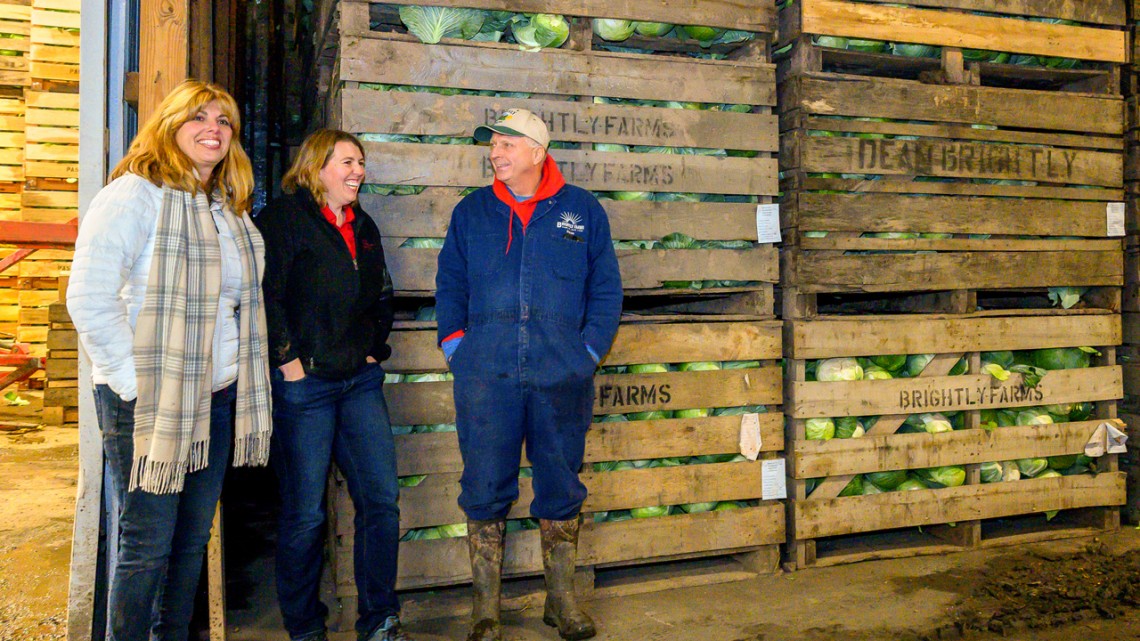ITHACA, N.Y. – Dean and Betsy Brightly of Brightly Farms, a 2,000-acre family farm in Hamlin, New York, expect federal food safety inspectors to pay them a visit this year.
All farms that meet market and income requirements and that grow fruits and vegetables commonly eaten raw are now required to comply with a new set of regulations aimed at keeping fresh fruits and vegetables – everything from salad greens, celery and carrots to berries and watermelons – free of microbial contamination from such pathogens as Listeria and Salmonella.
That’s not easy: The rule book is exceedingly complex, and understanding exactly what is needed to make one’s farm compliant is a daunting task.
Thankfully, Cornell Cooperative Extension (CCE) agents can make sure farmers understand what updates their farms may require.
Trained CCE extension agents teamed with New York State Department of Agriculture and Markets (NYSDAM) personnel across the state offer free and confidential on-farm readiness reviews. Agents walk through a farm and provide a wholistic assessment to insure that farmers can meet the new standards.
“If you’re looking at this large document with tiny writing without anyone explaining how it would fit your operation and your environment, can be overwhelming,” said Caroline Boutard-Hunt, an agricultural educator at CCE’s Yates County office.
The Food and Drug Administration’s new Food Safety Modernization Act (FSMA) Produce Safety Rule establishes, for the first time, science-based minimum standards for the safe growing, harvesting, packing and holding of fruits and vegetables grown for human consumption, according to the FDA website. Previous guidelines were voluntary.
The rule covers a wide range of areas, including: worker health and hygiene; worker training; agricultural water sources and irrigation practices; biological soil amendments of animal origin; post-harvest handling and sanitation; and potential contamination by farm animals and wildlife.
“These are the first federal regulations in our country regarding produce safety,” Boutard-Hunt said. “The goal of the Produce Safety Rule is to prevent outbreaks of microbial pathogens on food. This is a really important step to keep people safe.”
Though the rules went into effect in 2016, inspections began on a rolling basis in 2018, depending on a farm’s size.
For Brightly Farms, inspections begin this year for their 300 acres of cabbage and 80 acres of orchard apples, both of which qualify as produce commonly consumed raw.
Brightly Farms was already mostly up to speed, as Dean and Betsy undergo Global Good Agricultural Practice audits, commonly called Global GAPs.
Boutard-Hunt, along with an inspector from NYSDAM, visited them last fall for a free “On-Farm Readiness Review” to help answer questions and look at how to best ensure their current food-safety practices align to the new federal standards.
During the walkthrough, for example, the team pointed out a seam between two types of materials on an assembly line for processing cabbage that gathered organic matter and was difficult to keep clean.
“We had done a lot of the big things already,” Betsy Brightly said, noting they had fitted most of the cabbage line with seamless aluminum plates, for instance. “Pointing out those little things, that’s useful.”
Appropriate measures can vary from farm to farm. For example, New York state strawberries tend to be a perennial crop, but in Florida or California strawberries are annuals that are pulled out after the fruit is picked and new plants are sown the next season.
“Production practices aren’t always the same state to state or region to region,” said Elizabeth Bihn, director of the Produce Safety Alliance, a collaboration between Cornell, the FDA and the USDA, which trains growers about the FSMA Produce Safety Rule requirements. “Now consider the variation in growing practices for the 300 other commodities that we grow in this country,” Bihn said. “So when we talk about helping growers implement practices, it is almost impossible for anyone to sit in their office on the phone with a grower and say here’s exactly what you’re supposed to do. The practices need to be tailored to each farm.”
Additionally, food safety can have real costs on a farm. On top of the increased hours required for recordkeeping, there is added sanitation, monitoring and when necessary, upgrades to buildings and equipment. The Brightlys purchased a second $30,000 forklift, giving them one for indoors and one for outdoors, to prevent contamination from outside dirt and germs on the wheels from getting inside. Some farms build in other measures to keep the indoor areas clean, such as sanitized floor pads, though sanitation fluids can erode flooring. Farmers must absorb these costs on top of the rising price of labor, new overtime pay rules, and insurance policies.
“You have increased costs for pretty much everything,” Betsy Brightly said, “and you’re still not getting more for your product.
On the other hand, an outbreak of Listeria or Salmonella on a farm would be devastating.
“It’s important we work on this,” Boutard-Hunt said, “not just to keep people safe, but to help our farmers.” Economic repercussions of a foodborne outbreak can last for months or even longer if consumers change their buying habits to avoid a recalled food.
“Farmers work hard to grow nutritious and marketable food and it’s important to balance acknowledging their obvious care about their product with educating them on ways they can adjust their practices to reduce risk of contamination,” she added.
Cornell University has dedicated television and audio studios available for media interviews supporting full HD, ISDN and web-based platforms.
-30-
Original post https://alertarticles.info
